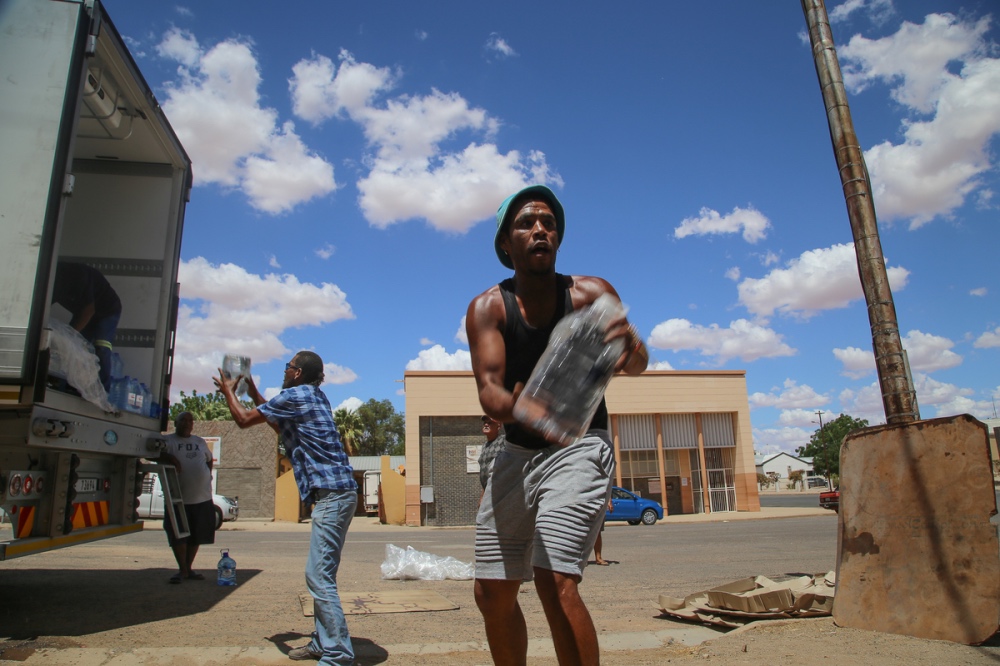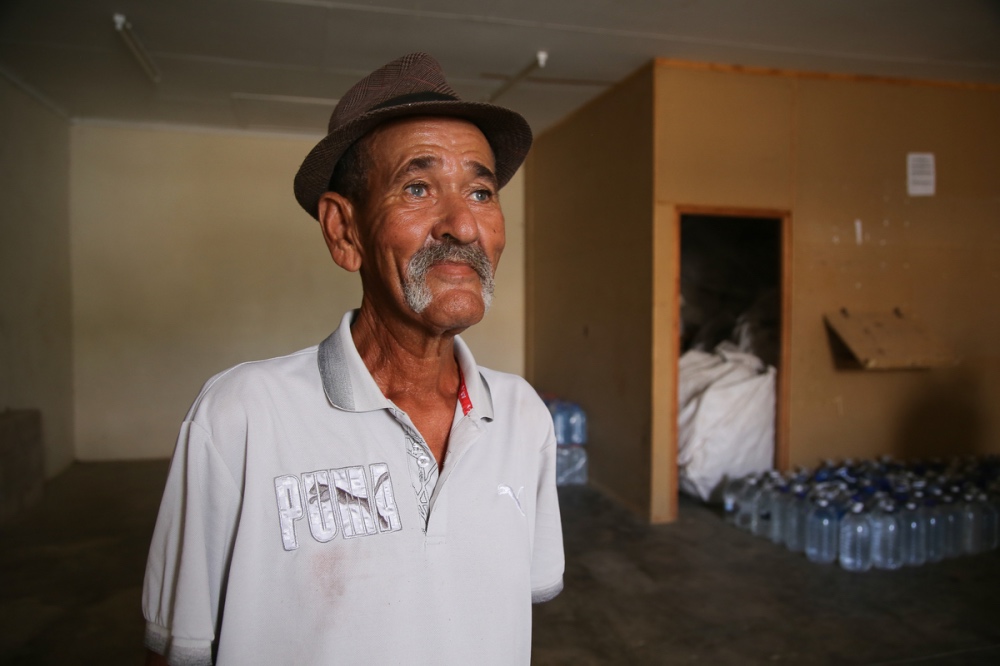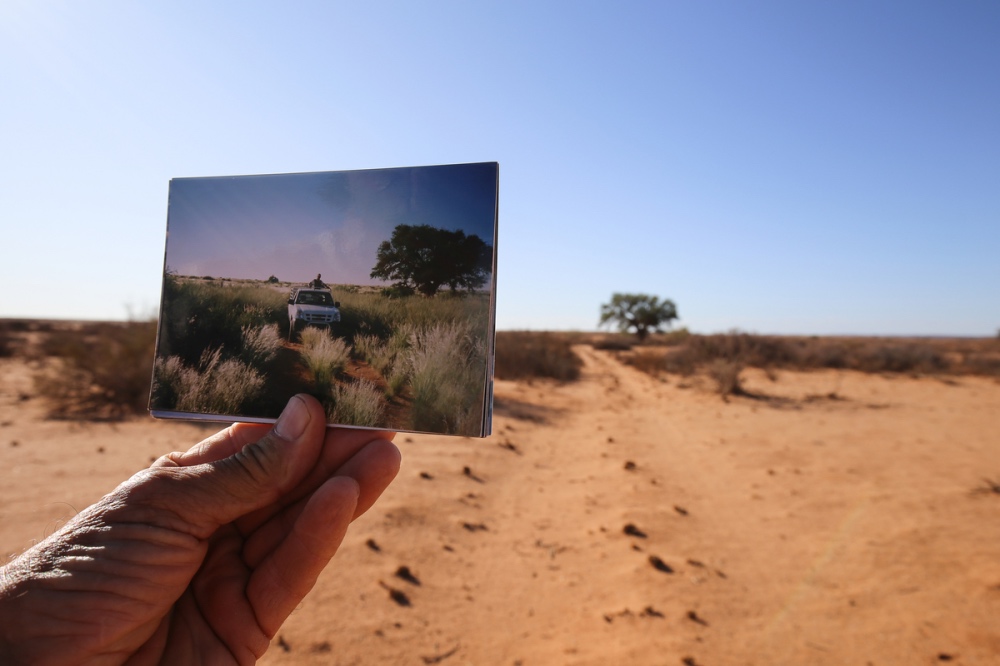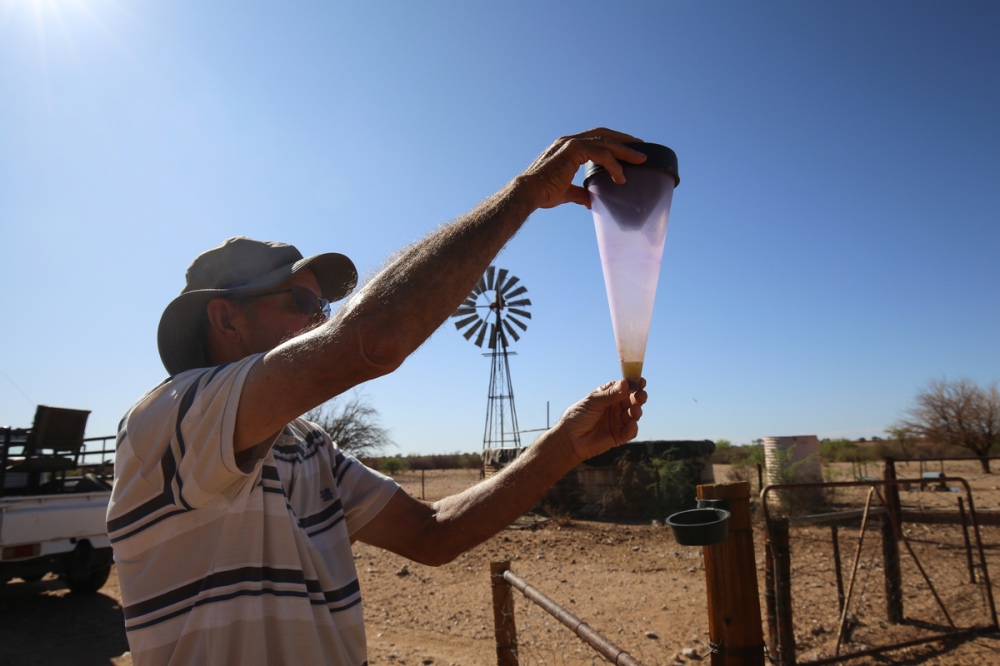
PETRO KOTZE reports for the Thomson Reuters Foundation from drought-stricken South Africa’s Northern Cape province…
Thomson Reuters Foundation
Kenhardt, South Africa
Livestock farmer Hermanus Willemse ekes a living from his small property just outside Kenhardt in South Africa’s Northern Cape province. He hasn’t seen a drop of rain since he started keeping sheep and goats three years ago.
“What’s happening to us now is exceptional,” he said.

ZA-Petro-Christopher Raats, whose grandfather is a local farmer, helps to offload donated water delivered this weekend by the SA Water Warriors. PICTURE: Thomson Reuters Foundation/Petro Kotze
Last year, the Northern Cape region clocked its lowest average recorded rainfall since 1933. That came on the back of an already devastating drought, now in its eighth year.
In this part of the world, wetter and drier periods usually alternate in cycles of seven to nine years, but the current drought was preceded by just two years of normal rainfall, said Willem Symington, head of disaster management at industry body Agri SA.
“What’s happening to us now is exceptional.”
– Livestock farmer Hermanus Willemse
By the time this drought started, pasture and water reserves were already below their usual levels.
The impact has been devastating for farmers across the province, where about 70 per cent of land is used for livestock.
For generations, farmers here have kept mostly cattle and sheep, although some breed game too.
Symington, also vice president of non-profit farmers’ group Agri Northern Cape, said red meat production in the province had plummeted 50 per cent since the drought began, causing devastating losses for farmers and knock-on effects in local communities.
But their plight has rallied South Africans countrywide to help, with donations of groceries, water, animal feed and even toiletries being driven in or sent by post.
Last weekend, the streets of the small town of Kenhardt were lined with locals in pick-up trucks waiting for the South African Water Warriors, a volunteer group.
They arrived with nine trucks of feed, a cooler truck of perishable goods, four trailers of groceries and 37,000 litres of water to distribute to the families of 355 farmers and farm-workers in the Kenhardt area.
Since the South African Water Warriors was set up two years ago, its members have delivered relief supplies to drought-hit farmers, mostly in the Northern Cape, said founder Deon Smit.

Small-scale farmer Hermanus Willemse. PICTURE: Thomson Reuters Foundation/Petro Kotze
Agri SA’s Symington, himself a farmer, said his peers were used to facing difficulties.
“We farm in hard country,” he told the Thomson Reuters Foundation. “But when it comes to donations, and people are good to you, that’s when you cannot control your emotions anymore.”
Standing in line for handouts is tough for people who have taken care of their families, workers, animals and communities for decades, he said. “But we are very thankful.”
At the onset of the drought, many farmers started adapting to the coming dry conditions according to accepted practices.
“Good pasture management is the bottom line for our people,” said Symington.
This approach has kept farmer Wynand Bezuidenhout standing through the worst of the drought so far.
“We farm in hard country. But when it comes to donations, and people are good to you, that’s when you cannot control your emotions anymore.”
– Willem Symington, head of disaster management at industry body Agri SA
He started reducing his flock early on, letting go of the breeding ewes first. His remaining sheep looked plump, in part thanks to the river running through his farm.
All that is left of the river is a broad expanse of soft, red sand but the groundwater has sustained a strip of riverine vegetation for his livestock.
Bezuidenhout has another advantage. Kicking up a trail of red dust as he marched across his farm, he pointed to a gnarly brown shrub, called gannabos, sporting small green leaves.
Only two things can kill it: overgrazing and drought, he said. But drought alone will not eliminate the bushes, he added.
The previous owner of the land Bezuidenhout bought 20 years ago practiced conservation farming, taking care not to overgraze his plots, keeping invasive plants to a minimum, and scattering the local gannabos seed whenever he could.
Bezuidenhout said farms with gannabos can sustain livestock for longer than those with only grass.
But he too is now digging into his dwindling funds to buy feed to sustain his animals, and his family is among those gratefully accepting donations.

Wynand Bezuidenthout’s farm in 2006, and now. PICTURE: Thomson Reuters Foundation/Petro Kotze
Symington said reducing livestock as pasture declines is common practice, even though it lowers production.
Under-stocking a farm with 20 per cent to 30 per cent less animals than its grazing can support during flush years provides a buffer against drought, enabling farmers to keep their livestock for two to three years longer when rains are poor.
In Northern Cape, the biggest risk is drought, Symington said, adding that the unusual length of the current drought meant many simply would not be able to continue farming.
Neither have they received adequate support from the government, he noted.
By December, 2019, an estimated R800 million ($US54 million) in relief funding was needed to feed remaining animals for three months.
“We will not stand up again. If your plans run out, what do you do then?”
– Farmer Memory Buis
But this January, the South African government announced R300 million would be set aside for emergency drought aid, following a R30 million allocation last year.
For many farmers, that is too little, too late.
Third-generation farmer Memory Buis has seen her flock of sheep reduced from 360 to 42.
“We will not stand up again,” she said. “If your plans run out, what do you do then?”
Symington said that if severe, prolonged droughts were to become the new normal, livestock farming would be under threat in the Northern Cape.
Meanwhile, he and many others have no alternative but to push on.
“I’m 55-years-old,” he said. “There is only one option: I have to make it work on the farm.”

Farmer Wynand Bezuidenhout on his farm just outside Kenhardt, four years into the ongoing extreme drought in February 2020. PICTURE: Thomson Reuters Foundation/Petro Kotze
Busy sorting flour, oil, long-life milk, snacks, deodorant and soap into separate packages for each family, farmer Buis thought a while when asked what helped the most.
“That people think of you,” she said.





